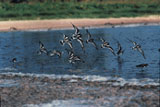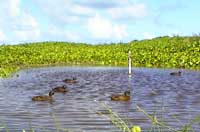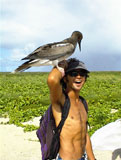|
You
are here: /main/about/laysan
island
Laysan
Island

 Laysan
is the second largest land mass in the NWHI (1,015 acres)
just behind Sand Island at Midway Atoll. It is about 1 mile
wide and 1-1/2 miles long and shaped like a poi board. The
island was formed from geologic forces pushing upward and
by coral growth. It has fringing reefs and a hypersaline (very
salty) lake in the middle of the island, the only lake in
the island chain, and one of only five natural lakes in all
of Hawai‘i. Laysan
is the second largest land mass in the NWHI (1,015 acres)
just behind Sand Island at Midway Atoll. It is about 1 mile
wide and 1-1/2 miles long and shaped like a poi board. The
island was formed from geologic forces pushing upward and
by coral growth. It has fringing reefs and a hypersaline (very
salty) lake in the middle of the island, the only lake in
the island chain, and one of only five natural lakes in all
of Hawai‘i.
The
island's easy access and large number of seabirds made it
a base for traders of guano (bird droppings used as fertilizer)
and feather harvesters in the late 1800s and early 1900s.
Although the practices were declared illegal, poachers killed
hundreds of thousands of birds and caused dramatic changes
in the island's ecosystem. Remnants of guano piles remain
from this era. Rabbits released in the early 1900s devastated
the island's vegetation. These events caused a public outcry
which led to the creation of the Hawaiian Islands Bird Reservation
by President Theodore Roosevelt in 1909.
 Laysan
has the fullest complement of all the bird species in the
NWHI. Huge populations of seabirds nest and migratory shorebirds
visit including Black-footed and Laysan albatross, Christmas
and wedge-tailed shearwaters, and bristle-thighed curlews.
Following the devegetation caused by rabbits, several land
birds became extinct including the Laysan honeycreeper and
millerbird, but two endemic land birds remain -- the hardy
Laysan finch and Laysan duck. Of the 75 native invertebrate
species found on Laysan, 15 are endemic. Laysan
has the fullest complement of all the bird species in the
NWHI. Huge populations of seabirds nest and migratory shorebirds
visit including Black-footed and Laysan albatross, Christmas
and wedge-tailed shearwaters, and bristle-thighed curlews.
Following the devegetation caused by rabbits, several land
birds became extinct including the Laysan honeycreeper and
millerbird, but two endemic land birds remain -- the hardy
Laysan finch and Laysan duck. Of the 75 native invertebrate
species found on Laysan, 15 are endemic.
 Surrounding
the lake, the beautiful encircling white sand beach is topped
by dry coastal grasses. Sedges grow thick near the lake's
edge. Over 30 kinds of plants live on Laysan. In addition
to the koloa, the Laysan duck is Hawai`i's "other"
native duck species. This striking endemic duck has developed
a fascinating eating habit: it runs on mud flats while snapping
at swarms of brine flies to retrieve its meal. Surrounding
the lake, the beautiful encircling white sand beach is topped
by dry coastal grasses. Sedges grow thick near the lake's
edge. Over 30 kinds of plants live on Laysan. In addition
to the koloa, the Laysan duck is Hawai`i's "other"
native duck species. This striking endemic duck has developed
a fascinating eating habit: it runs on mud flats while snapping
at swarms of brine flies to retrieve its meal.
Much of the shoreline at Laysan is composed of upraised,
old coral reef, and coral sand which over time has become
cemented together to form rock. This creates a rocky intertidal
habitat which is very rich and hosts numerous invertebrate
species, algae, and juvenile fishes. Although the reef at
Laysan is the smallest of the NWHI (145,334 acres), it is
quite rich. Numerous sea turtles and monk seals appear on
the island. Several species of Hawaiian surgeonfish and large
schools of convict tangs are in the shallow, wave-washed
waters around the island. Twenty-eight species of stony coral
are reported, and branching corals are common. Most of the
shallow water reef habitat is in a protected bay on the southwestern
side of the island, while most other reef areas are in deeper
waters.
 Although
a host of introduced species changed the "original fabric"
of the island's ecology, this place has benefited from years
of effort to "malama" (take care of) the island.
Efforts by the U.S. Fish and Wildlife Service have eliminated
pests, rats, rabbits, and weeds, and restored native vegetation.
As a result, finch and duck populations are increasing. Laysan,
the poster child for restorative island efforts, is considered
one of the "crown jewels" of the NWHI. Although
a host of introduced species changed the "original fabric"
of the island's ecology, this place has benefited from years
of effort to "malama" (take care of) the island.
Efforts by the U.S. Fish and Wildlife Service have eliminated
pests, rats, rabbits, and weeds, and restored native vegetation.
As a result, finch and duck populations are increasing. Laysan,
the poster child for restorative island efforts, is considered
one of the "crown jewels" of the NWHI.
<<back
-- next>>
 Talk About It! Talk About It!
Vegetation around the lake
Asked by Mike on Mar 2, 2005.
I was wondering more about the terrain of around the lake. Any trees?
Answered by Angela Anders, US Fish & Wildlife on Oct 5, 2005.
The terrain around the lake on Laysan consists mostly of shrubs, grasses, and forbes, but no trees.
Thanks for your question! Seeking opportunities to volunteer in NWHI
Asked by Natalie on Jul 11, 2008.
I plan on retiring to Hawaii in 1 year and 11 months (we've been researching for a few years) and I'd like to know about every possible volunteer job you have in the NWHI for someone who loves the Ocean and all who depend on it and don't have a voice. Any advice?
Answered by Dan from University of Hawaii on Jul 24, 2008.
This opportunity was recently posted:
- - - - - - - - - - - - - - - - - - - - - - - - - - - - - - - - -
July 21, 2008
Volunteer to work on Laysan Island
The USFWS is looking 1 volunteer to assist with non-native plant control, endemic plant propagation, plant monitoring and bird surveys for approximately 6 months. Work would be on Laysan Island, Papahanaumokuakea Marine National Monument. Expenses covered by USFWS are: food, housing, transportation w/in continental US to Honolulu and Laysan and return, clothing and tools to do work. Approximate start date is Aug 25, 2008 thru end of March 31, 2009. People interested in this opportunity should send resume with references to cindy_rehkemper@fws.gov. |